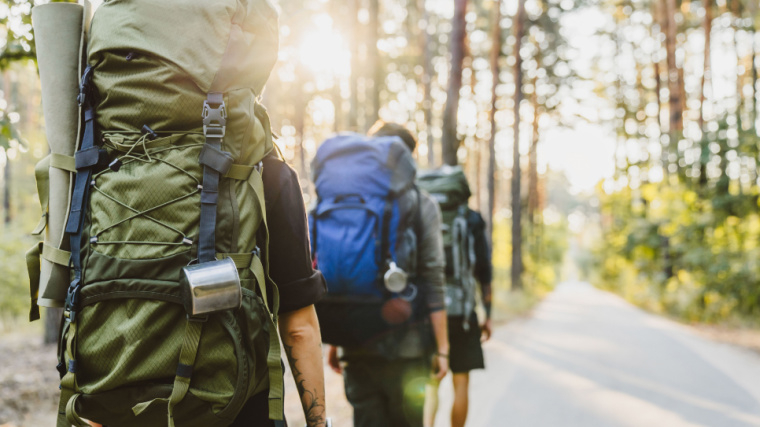If you stay tuned in to the health & fitness industry, it might feel like rucking is, well, everywhere. And that’s because it is. According to Google Trends, search volume for the term “rucking” has been steadily on the rise for the better part of half a decade now.
Among American exercisers, there’s particularly high interest in states like Hawaii, Montana, and North Carolina. What do they have in common? The great outdoors.

Rucking is a military-inspired form of heavy-duty cardio that is gaining popularity among outdoors enthusiasts, functional fitness folk, and recreational hikers alike. If you’re curious about rucking — the benefits of it, where it came from and, most importantly, how to get started — you’ve come to the right place.
What Is Rucking?
Despite its somewhat mysterious name, rucking is actually beautifully simple; it’s, essentially, walking with a weighted backpack. That’s all there is to it. If that sounds just like hiking, well, that’s because the two are essentially synonymous if you’re doing it in nature.
However, you can ruck anywhere, including throughout your neighborhood or in a bustling city. The rucking movement credits part of its newfound virality to the U.S. military — members of the armed forces are tested regularly on their ability to carry service equipment over long distances. The large camouflage backpack utilized in every branch of the military is even called a rucksack.

[Read More: The 6 Best Weighted Vests]
While “ruckers” may tip their hats to active-duty military, rucking as an exercise modality is about as versatile as it gets. It’s a form of lightly-loaded cardiovascular conditioning training, making it viable for CrossFitters — there was even a ruck event at the 2019 CrossFit Games — athletes, and the average Joe or Jane just looking to change their lifestyle.
If you’re a functional athlete (think CrossFit, HYROX, or even a Tough Mudder) you need to have at least a general acquaintance with rucking. Long-distance loaded cardio is becoming more and more popular in these sports and events.
Benefits of Rucking
As far as exercise trends go, rucking boasts a strong portfolio of benefits. If you’re debating starting out with rucking, here’s some of what you stand to gain:
Simple and Easy To Start
Some health “fads” come with large practical, or financial, barriers to entry. If you want to start doing cold plunges, you need a tub. Interested in doing Olympic lifting at home? You’ll need the right barbell, a lifting platform, and plenty of bumper plates.
Rucking sidesteps these hurdles. Sure, the right rucksack and a good pair of cross-trainers can make it more comfortable, but they aren’t strict prerequisites. As long as you have the time to walk and some sort of backpack to chuck some weight into, you’re in business.
Adds Socialization to Exercise
If you’re a gym rat, you know how isolating your strength training routine can feel from time to time. After all, most folks work out alone most of the time. There’s certainly nothing wrong with sequestering your fitness routine and reserving it for some quality “you” time.
But rucking, by nature, encourages healthy social interaction. Intense cardio like HIIT is too challenging to perform while carrying on a conversation. By contrast, rucking is just “easy” enough that you can ruck alongside a friend or romantic partner.

[Read More: The Best Online Workout Programs For Coaching, Cardio, Value, And More]
Some scientific research has shown that partner or group-based physical activity can enhance the benefits of exercise. (1) You may reduce stress further and get a more productive workout if you opt to ruck alongside others rather than go it alone.
Incorporates Progressive Overload
Cardiovascular exercise comes with a long list of health and performance-related benefits. That said, with most forms of cardio you can only drive progress in a few ways. Typically, you have to move faster or for a longer duration.
Rucking opens up another avenue of progression that can diversify your workouts. Adjusting the amount of weight you ruck with can easily increase, or decrease, the challenge of your session. If you focus on gradually increasing the amount of weight you carry on your back, you’ll build more muscular strength and endurance without having to commit more time itself.
[Read More: Everything You Need to Know to Build Your First Workout Program]
Note that rucking isn’t strictly considered resistance training; it is cardiovascular exercise with external resistance added. That said, the research on load-based progressive overload is crystal clear. Challenging your body with more weight over time directly leads to better gains. (2)
Gets You Outdoors
You don’t necessarily have to ruck outdoors. You might get some funny looks, though, if you decide to ruck for an hour on a treadmill in a commercial gym. Rucking is, by and large, a fun-in-the-sun activity. Moreover, it’s a health-conscious reason to immerse yourself in nature and bolster your fitness in the process.
Plenty of studies have demonstrated a consistent trend: Exercising in nature enhances many of the benefits you receive. Some data have argued that exercise and exposure to nature have a “synergistic effect,” where one perpetuates the value of the other. (3)
Rucking is the perfect excuse to hit the trails and surround yourself with greenery rather than coop yourself up inside a fluorescent, climate-controlled gym.
General Health Benefits
Achieving and maintaining a high daily step count is one of the best proactive measures you can take to guarantee a long and healthy life. In fact, there’s a pretty consistent relationship between daily step count and reducing all-cause mortality risk. (4) These effects may even be compounded if you habitually ruck alongside a group of your peers. (5)
[Read More: Active Stretches Explained — Selections for Optimal Recovery & Performance]
You may also find that weighted walking enhances your muscular strength, endurance, and improves your posture. Your muscles will have to adapt to the extra load and become more robust in the process.
How To Start Rucking
As far as new hobbies go, rucking is pretty plug-and-play. In fact, you only really need one specialty item — a good rucksack or backpack. After that, it’s one foot in front of the other.
[Read More: Best Posture Correctors That Provide Posture Support]
- Step 1: You’ll need a sturdy rucksack or backpack to carry weights in. Aim for something with cushioned shoulder straps and, if you prefer, a waist cinch to help keep the bag snug to your torso.
- Step 2: Add weight to your backpack. Start with less than you think (five or ten pounds should be plenty) and build up over time as you acclimate to rucking.
- Step 3: Start walking. That’s all there is to it. A good benchmark to aim for is a 15-minute/mile pace.
Rucking Tips From a Pro
There’s no shame in feeling a bit daunted by the prospect of slinging a heavy bag on your back and walking for what will probably feel like forever. For members of the military, though, rucking is close to a way of life.
Take it from Michael B. Brennan — a Warrant Officer and Chinook helicopter pilot for the U.S. Army. Brennan also boasts a B.S. in Exercise Science and has personally trained multiple candidates for Special Forces Assessment and Selection.

Here are a few of Brennan’s key tips for success on your first (or second, or fifth) ruck:
Keep It Simple (and Cheap)
“Don’t spend a fortune on rucking, especially as a beginner. You can get a surplus rucksack or assault pack for about 30 dollars,” Brennan says. He notes that spending extra money on equipment for rucking may not tangibly enhance your experience with it.
Prioritize Your Feet
Brennan notes that a successful ruck starts and ends with how you treat your feet. After all, you’ll be pounding the trails thousands of times per hour. “About a week before a big ruck, I’ll always get a pedicure. Seriously, it helps remove any potential for ingrown toenails and clears away calluses before they can crack,” Brennan says.
[Read More: The 5 Best Quad Workouts for Forging Bigger and More Explosive Legs]
He also notes that your footwear of choice should protect your feet from the elements, but otherwise be light and breathable if possible. If you know you’re going to ruck through wet conditions or muddy terrain, opt for something more heavy-duty.
Play to Your Strengths
Rucking is, essentially, loaded walking. But that doesn’t mean you can’t maximize your efficiency and play to your strengths when you ruck, Brennan says. If you have long legs, take advantage of them and go for wide, sweeping strides.

[Read More: Get Freakishly Strong With the 5×5 Workout Program]
Conversely, if you’re of a stockier build, you may have success with a very light and short-stepping jog, called a shuffle. He also suggests taking it easy on uphill portions of a ruck and letting gravity do most of the work when you’re heading downhill.
Start Slow(er Than You Think)
“Not every ruck needs to be max-effort. In my experience, people respond plenty well to low-frequency training when it comes to rucking. One or two days per week, incrementally increasing weight or distance, is more than enough for beginners,” Brennan says.
He notes that this kind of ramp-up protocol for rucking is about familiarizing your body with the equipment and ensuring your joints and muscles have enough time to adapt to the stimulus. You may also want to try what Brennan calls “tempo rucks” — rucking for just a mile or two at a time, instead of going for long distances. This can help you develop your tolerance to rucking without creating too much wear and tear or delayed-onset muscle soreness (DOMS).
FAQs
Got some questions before you start rucking? No worries. Here are some common rucking FAQs and their answers:
What is the ideal weight for rucking?
35 pounds of equipment — not counting any water you may carry to hydrate during your ruck — is the standard, according to Brennan. If you’re new to rucking, start with very light weights and work your way up.
Is it okay to ruck every day?
You can ruck on a daily basis if you only cover short distances (think no more than 2 or 3 miles). There’s no reason to ruck for long distances on a daily basis, it may predispose you to injury.
What are the risks of rucking?
Rucking adds weight to your torso but not to your legs. As such, carrying a heavy ruck may affect your balance and stability, especially if you’re rucking in the wilderness or on unstable or slippery terrain. Be mindful of these risks and slow down to avoid taking a nasty fall.
What is the best way to pack a ruck?
Brennan recommends packing “squishy” material towards the bottom, such as towels or clothing. The closer you get to the top of your pack, the more dense your equipment or weights should be. Your aim is to keep a bulk of the weight in your ruck close to your shoulders, not down by your lower back.
How long should you rest between rucks?
Between intense rucks covering long distances, or after any type of evaluation or competition involving a ruck, you should take at least a week off altogether from rucking.
References
- Plante, Thomas & Coscarelli, Laura & Ford, Máire. (2001). Does Exercising with Another Enhance the Stress-Reducing Benefits of Exercise?. International Journal of Stress Management. 8. 201-213. 10.1023/A:1011339025532.
- Williams, T. D., Tolusso, D. V., Fedewa, M. V., & Esco, M. R. (2017). Comparison of Periodized and Non-Periodized Resistance Training on Maximal Strength: A Meta-Analysis. Sports medicine (Auckland, N.Z.), 47(10), 2083–2100.
- Gladwell, V. F., Brown, D. K., Wood, C., Sandercock, G. R., & Barton, J. L. (2013). The great outdoors: how a green exercise environment can benefit all. Extreme physiology & medicine, 2(1), 3.
- Paluch, A. E., Bajpai, S., Bassett, D. R., Carnethon, M. R., Ekelund, U., Evenson, K. R., Galuska, D. A., Jefferis, B. J., Kraus, W. E., Lee, I. M., Matthews, C. E., Omura, J. D., Patel, A. V., Pieper, C. F., Rees-Punia, E., Dallmeier, D., Klenk, J., Whincup, P. H., Dooley, E. E., Pettee Gabriel, K., … Steps for Health Collaborative (2022). Daily steps and all-cause mortality: a meta-analysis of 15 international cohorts. The Lancet. Public health, 7(3), e219–e228.
- Hanson, S., & Jones, A. (2015). Is there evidence that walking groups have health benefits? A systematic review and meta-analysis. British journal of sports medicine, 49(11), 710–715.
Featured Image: GaudiLab / Shutterstock
The post Everything You Need To Know About Rucking (+ How To Get Started) appeared first on BarBend.
